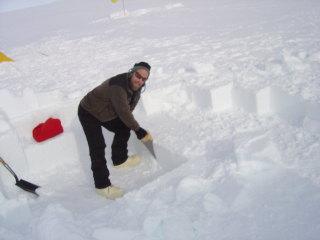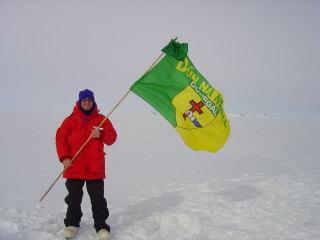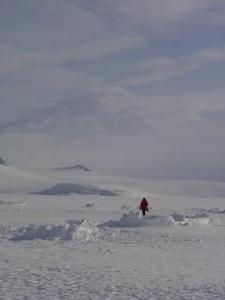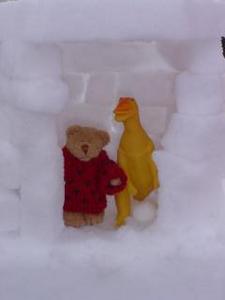
|
|
20 November, 2003
I 'm a certified "Happy Camper"!
You may have noticed there is a gap in my journal since I first arrived here in Antarctica, this was due to the compulsory "Happy Camper" training all new people who are going out into the field must take. Although I love winter camping and am fairly practiced at it, Antarctica opens up a whole new dimension to the concept. We started our "Happy Camper" in a classroom where the instructors roughed out the game plan for the next two days. I quickly realized that I would learn a few new tricks and also come to appreciate a few of the advantages campers have here in Antarctica. Although we were essentially car camping, the fact remains that you can in short order, easily drive out to a place that is pretty desolate, not North Country desolate, (where I am used to camping) but Antarctic desolate, you look around and there are no trees, plants, birds or bees. And although you can see specs (human activity) off in the distance, you realize a lot can go wrong before any one would notice, or if they did, it would take some time to get to you and you could become past tense in no time at all. This coupled with the fact that the weather can change in an instant gives you reason to hang on every word the instructors have to say.
Brian, the head instructor, gave us the briefing and laid out the plan for the two-day experience. Basically, the course is designed to get us familiar with the environment we will be in, and equipment needed to survive in such a harsh place. To that add a dose of confidence and some coping skills and we should be ready to take care of business in the event of an emergency.
When you go out to the field you take along all the gear you need to accomplish you r mission, science equipment and living essentials. However when you leave your remote campsite for an even more remote work site you probably only take your science gear and some food and drink to make it through the day. That's why, where ever you go, they send along a Survival Kit. One or two person depending on the type of vehicle you will be using, and the distance you will be traveling. From snow sled to Piston Bully, every traveler needs one and like American Express, "Don't leave home without it." We opened a survival bag in the classroom and talked about each piece of gear found inside. There is a snow saw, snow shovel, stove, fuel, tent, sleeping bag, ground pad, cook kit and freeze dried food rations, usually enough for a few days on your own. I may have missed something, but you get the point. We then went out to our snow school site, which is on the other side of the ridge from McMurdo, just past The Kiwi's Palmer Station. Here in the relative comfort of instructor's tent, we practiced using the two basic types of mountain stoves, realizing that cold weather makes your fingers less dexterous, the practice was invaluable. Completing that, we then left for our campsite, there the instructors showed us various techniques in snow shelter construction, and we also set up a Scott tent and a few mountain tents. Confident in our newly acquired skills, the instructors left and retired to the safety of the heated instruction tent about 1/4 mile up the "road". Many of the campers opted to build a sleeping trench, a few decided to sleep in the Quincy (I'm not sure of the spelling, but you pile your sleep kits in a mound, cover it with snow, pack it down and then pull the bags our from the bottom. It gives you a relatively quick and secure igloo). I opted to sleep in a mountain tent (go with the familiar) so I spent my time building "Chez Antarctica" cutting blocks of snow, I dug down and raised up walls to give us a communal sheltered area to melt water, sit out of the wind and eat a wonderful meal of freeze dried whatever, together. It turned out to be the social event of the trip. We were able to spend time relating our experiences, research projects and general reasons about how we ended up here. Since the sun refused to set, it was up to our brains to tell us when to sleep. We all retired around 11pm and for the most part, all had a good night sleep. I was happy I brought the blinders I got on the plane trip from LA to Auckland. Up to now, I have been sleeping in one of the inside room of the main dorm building and there are no windows there so it can be dark as a cave but outside, the sun never dropped below 20 degrees above the horizon so at 3 AM it looked like 3 PM.
The next morning we boiled water, broke camp and the instructors came and got us. We shared our experiences (what they called de-briefing) and then got some more instruction on radio set up and usage as well as how to find lost people in zero visibility.
That about wraps up the program, the biggest difference I discovered in the exercise was one, the air is so dry, that my tent never frosted up like it does in the Adirondacks and so I was quite warm and comfortable all night. The second was how wonderful the snow is to play in, cutting snow blocks and building walls and benches was like moving great blocks of Styrofoam around (Ok, it is a bit heavier) into cool shapes. It is king of like having the ultimate Lego set!
The one bad piece of news we got upon return from snow school, was that our PI's (Primary Investigator) Hercules Airplane was turned around due to weather, so he will be delayed getting in. This may delay our trip to the glacier camp but we still have so much to do here it is really not a big problem.
Take Care,
Andy

TEA's Andy and Amy look for Brian the "Lost" instructor. Why do we carry a rope?

Building the communal dining hall.

Dining at "Chez Antarctica" Where all the "cool" people eat!

Patrick Boyle, a member of the TRACER program waves his Irish banner staking a claim to Snow Mound City.

A lone walk towards Mt. Erebus.

Dino meets the Shackleton Bear at Snow Mound City.
Contact the TEA in the field at
.
If you cannot connect through your browser, copy the
TEA's e-mail address in the "To:" line of
your favorite e-mail package.
|
